Oil Pressure Sender
Discussion
Discopotatoes said:
I'm in need of a new sender but can't see any 100 psi ones on eBay they all seem to be 150 is this going to be suitable?
Hi Rich, I'm using an Ispro R8917-03.http://www.pistonheads.com/gassing/topic.asp?h=0&a...
I only fitted it four months ago so it's longevity is yet to be fully tested, but I have to say I'm really happy with it so far.
Alun reported when using this sender his gauge read 15psi at rest with the engine off, so the suggestion is the sender over reads by 15psi or more with the engine running too.
http://www.pistonheads.com/gassing/topic.asp?h=0&a...
This has not been my experience with the Ispro R8917-03, to show this I've just popped out the the garage to take some snaps.
Ignition off...
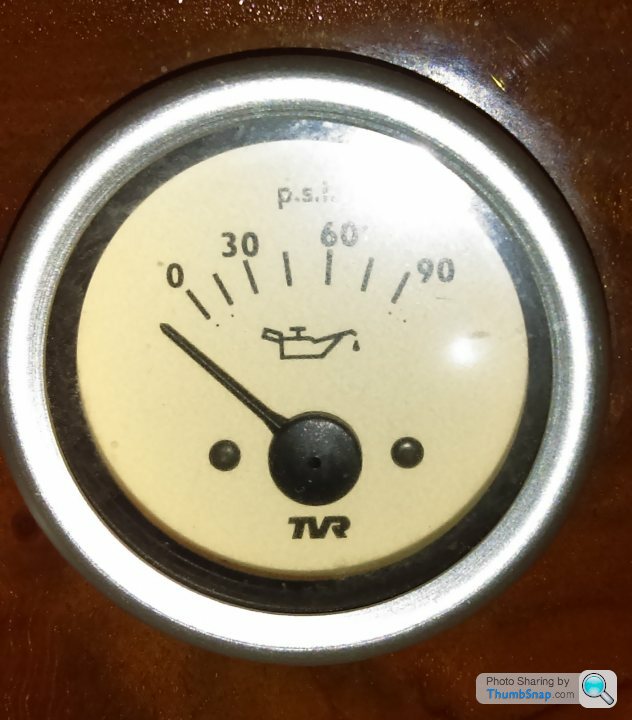
And now with ignition on (engine not running)....
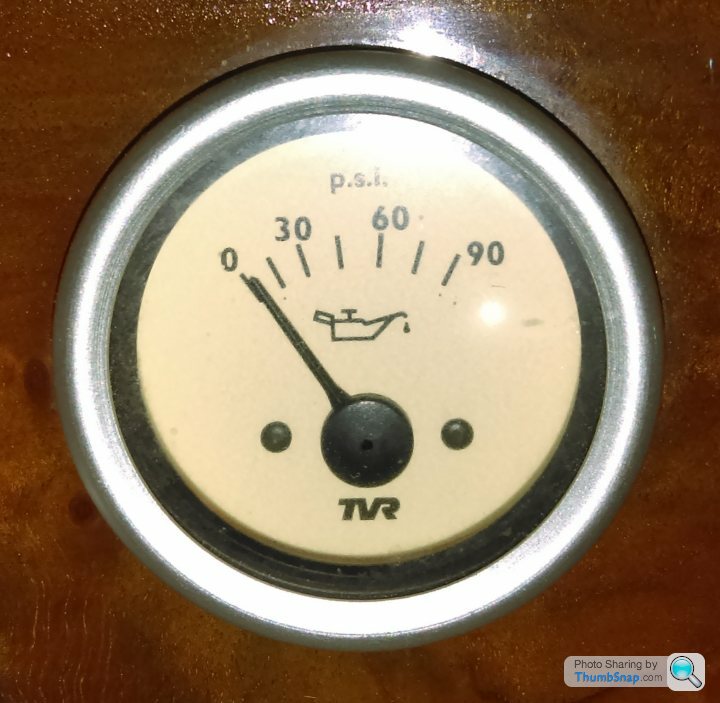
See... as close to the zero mark as you're ever likely to get, and with the engine running my pressures match what I've seen on a Sykes Pickavant professional mechanical oil pressure gauge plumbed directly into the engine.
Basically (& with the V8 Developments OP spring mod) I see the following:
Cold idle: 40psi
Hot Idle: 33psi
Cold over 2,000rpm: 60psi
Hot over 2,000rpm: 55psi
I can certainly see why Alun saw the wrong readings if his gauge was reading 15psi at rest and with the engine off, but the Ispro sender certainly worked for me on my 1996 car with magnolia Caerbont gauges. Perhaps the issue for Alun related to an incompatibility between the Ispro sender his later pure white faced gauges?
The American made Ispro R8917-03 seems significantly better built than any sender I've handled before including Jag XJ6 ones and the TVR original. For a number of years I'd been using a cheap eBay sender to good effect until it started weeping a bit, saying that apart from a few oil drips it continued to work perfectly right up to the day I removed it, and that was roughly five years service for just £15 so I'm hardly complaining.
The Ispro sender is more expensive but it's definitely better built than the TVR original or the cheapo eBay sender, and it works perfectly for me, but will it last

It's heft & build quality seems to suggest it will... but only time will tell

Edited by ChimpOnGas on Tuesday 28th February 20:23
Its all in my post here mate...
http://www.pistonheads.com/gassing/topic.asp?h=0&a...
But to save you the pain of reading all my waffle, I've sliced out the relevant bit for you....

http://www.pistonheads.com/gassing/topic.asp?h=0&a...
But to save you the pain of reading all my waffle, I've sliced out the relevant bit for you....
ChimpOnGas said:
The Ispro R8917-03 is quite a bit more expensive than the cheapy Chinese ones but still a lot cheaper than the ones sold by the TVR parts specialists. It's also quite a bit longer, I had to jack my engine slightly to get it started on the thread, once started it screwed in perfectly and there were no clearance issues whatsoever when I took the engine weight off the jack.
Dave 
Alun if all this really bothers you, now you spent money on the Ispro sender, why not just tune it with a variable resistor? Once you've established the Ohm figure you can simply fit a resistor of the correct fixed value.
This is what I did with my Range Rover temp sender mod, and it works perfectly; unlike when I suffered TVR's poor original sender location/arrangement my TVR temp gauge now follows what my Canems ECU software shows. So with just a glance at the gauge I now actually know what my coolant temps really are... which is nice.
The Ispro sender is a quality thing that gives accurate readings if like me you have Caerbont gauges, and for people with later cars that have the white faced gauges for not much more than a pound you too can get the benefit of a better built sender and see the right figures on your gauge.
A couple of quid on some resistors has to be better than paying £60 or more for one of the rip-off original senders that in truth are nowhere near the quality of the nice & solid American made Ispro one.
This is what I did with my Range Rover temp sender mod, and it works perfectly; unlike when I suffered TVR's poor original sender location/arrangement my TVR temp gauge now follows what my Canems ECU software shows. So with just a glance at the gauge I now actually know what my coolant temps really are... which is nice.
The Ispro sender is a quality thing that gives accurate readings if like me you have Caerbont gauges, and for people with later cars that have the white faced gauges for not much more than a pound you too can get the benefit of a better built sender and see the right figures on your gauge.
A couple of quid on some resistors has to be better than paying £60 or more for one of the rip-off original senders that in truth are nowhere near the quality of the nice & solid American made Ispro one.
bobfather said:
I think you're kidding yourself if you think the expensive sender will be more accurate. The mechanism is the same in all these senders. Price difference may give you a better build quality but it won't give you better technology. Ultimately these sender/gauge combinations are only designed to indicate approximate values
I think you've misunderstood me Bob, I'm not saying and have never suggested the Isspro sender will be more or less accurate than any other bellows type resistor sender, assuming that is we are talking about a correctly gauge matched 0-100psi sender that is! (not the incorrectly matched 0-90psi VDO Jag XJ6 sender used by TVR)Indeed if you read my original post on this...
http://www.pistonheads.com/gassing/topic.asp?h=0&a...
You'll see I make this statement...
ChimpOnGas said:
My personal opinion is all these senders are flawed by design, they work by hot engine oil acting on a rubber diaphragm which in turn acts on a variable resistor. Hot acidic engine oil acting on a rubber diaphragm isn't exactly recipe for longevity so you could argue the cheapy Chinese ones are a better bet because they only cost about £12 a time.
I also said this...ChimpOnGas said:
I can't tell you if the Isspro R8917-03 is better or will hold out longer than the five years I got from my cheapy Chinese sender but it does feel better made, only time will tell if it lasts 
Having spent my formative years restoring and repairing British classics I'm more than familiar enough to confirm this type of sender is never that long lived, their accuracy is also never as good as a capillary gauge.
TVR used a VDO bellows sender, basically it's exactly the same as and interchangeable with the sender from an old Jag XJ6. Every Chimaera & Griff I've ever seen still running the original VDO sender gives the wrong reading. They all show you a figure that's roughly 10psi lower than reality when you check it against a proper mechanical gauge plumbed directly into an oil gallery. This was a pairing/compatibility issue between the sender and gauge, the original VDO senders are also rather poor quality.
The TVR Caerbont gauge operates over a 0-100psi range, the highest number shown on the gauge is 90psi but look closer and you'll see it has the two dots at both ends of it's scale indicating the areas of risk, ie if the engine is running and the needle sits within the lower two dots (0-14psi) at idle you have a dangerously low oil pressure, and a dangerously high oil pressure at speed if the needle reaches the upper two dots (90-100psi).

TVR (or more likely their gauge supplier) probably only used he old Jag XJ6 VDO sender because there were loads of cheap unused ones available from Jaguar at the time, the Jag sender and gauge are correctly paired both operating over a 0-90psi range, to reaffirm this point here's a Jag XJ6 oil pressure gauge...
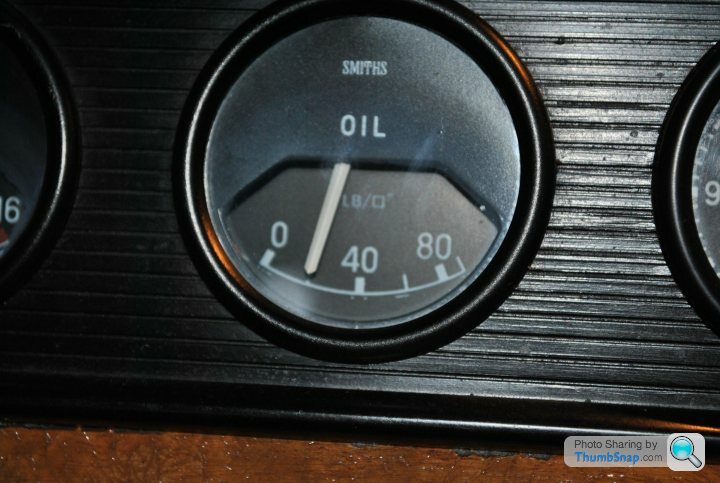
As we can see it's a 0-90psi gauge not the 0-100psi gauge we have, so TVRs use of the parts bin XJ6 0-90psi sender paired with the Caerbont 0-100psi gauge was always going to give readings that are roughly 10psi lower than they really are.
It's also why my Isspro R8917-03 sender gives the correct oil pressure readings on my Caerbont 0-100psi gauge.
http://www.issprogauges.com/0-100-PSI-Oil-Pressure...
Personally I would never fit the overpriced, poor quality, and inaccurate one sold by the TVR parts specialists.
I have no idea how long my Isspro R8917-03 sender will last, and as I've already been careful to point out all these bellows resistor type senders are flawed by design. But what I can tell you is if you have Caerbont gauges this sender will give you the right readings, the separate dedicated earth terminal and the sender's overall feel of superior build quality are also significant benefits offered by the Isspro sender over the VDO original.
It's cheaper too, so if you have Caerbont gauges I call that a no-brainer

Clearly there's something different about the the later pure white faced gauged used by TVR, my guess is they finally worked out the incomparability issue with the XJ6 sender and created a gauge that was correctly paired to all those Jag senders they still had. If you do have a later car with these pure white gauges it seems highly likely you need a 0-90psi sender, unfortunately Isspro only offer senders in the three following ranges:
- 0-80psi
- 0-100psi
- 0-150psi
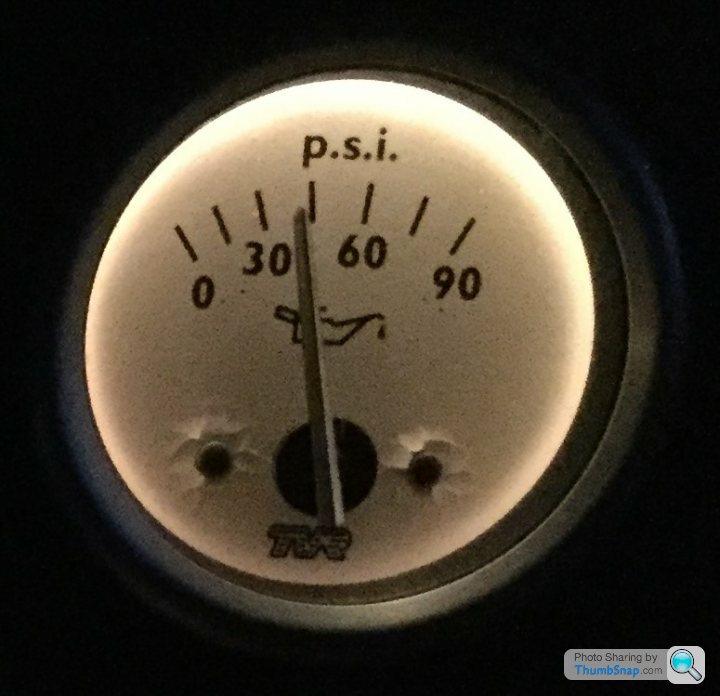
Compare this with the earlier Caerbont gauge I have where the last of the two dots clearly ends at the 100psi point, making it a 0-100psi gauge.

So all you need to do is choose your sender correctly, and you'll see the correct readings!
Edited by ChimpOnGas on Wednesday 1st March 08:32
Alun, study my last post paying particular attention to the last two images.
It's clear to me my earlier Caerbont gauge is a 0-100psi gauge, while your later pure white faced gauge operates on the 0-90psi range.
This is why the Isspro sender works perfectly for me but gave you the wrong/higher readings.
Quite simply... you need a 0-90psi sender.
It's clear to me my earlier Caerbont gauge is a 0-100psi gauge, while your later pure white faced gauge operates on the 0-90psi range.
This is why the Isspro sender works perfectly for me but gave you the wrong/higher readings.
Quite simply... you need a 0-90psi sender.
Of course the easiest solution is...
If you have the later pure white faced 0-90psi oil pressure gauge like this...

You need to select a 0-90psi sender, and there a loads on eBay for around £15 that will work just fine.
And it also looks like the ETB gauge fitted very early Chimaera's was 0-90psi....
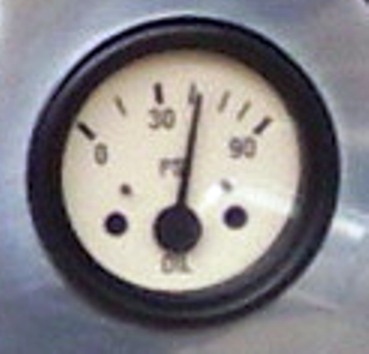
On the other hand if you have the mid production Caerbont 0-100psi gauge that came between the early ETB and late model pure white faced 0-90psi oil pressure gauge which looks like this....

You need to select a 0-100psi sender, and for that the Isspro R8917-03 is perfect as I've proved.
In my opinion none of the TVR gauges should be considered precise instruments, if they give you a decent reliable reading within the acceptable operating range we should view this as perfectly acceptable.
But in the end it's just a simple case of selecting the right sender to go with the right gauge.
If you have the later pure white faced 0-90psi oil pressure gauge like this...

You need to select a 0-90psi sender, and there a loads on eBay for around £15 that will work just fine.
And it also looks like the ETB gauge fitted very early Chimaera's was 0-90psi....

On the other hand if you have the mid production Caerbont 0-100psi gauge that came between the early ETB and late model pure white faced 0-90psi oil pressure gauge which looks like this....

You need to select a 0-100psi sender, and for that the Isspro R8917-03 is perfect as I've proved.
In my opinion none of the TVR gauges should be considered precise instruments, if they give you a decent reliable reading within the acceptable operating range we should view this as perfectly acceptable.
But in the end it's just a simple case of selecting the right sender to go with the right gauge.
Paulprior said:
I read 30 psi, hot, cold, tickover or high revs, I assume this can't be right?
You're right it's not, but this is pretty much how these cars came from the factory, well often the gauge would show 15psi at idle rising to an absolute maximum of 35psi at speed, basically it was wrong from day one because while the true idle pressure could be as low as 15psi the higher over 2,00rpm figure should be more like 50psi not 35.Paulprior said:
From the experience of you guys should I target the gauge or sender first?, maybe do a resistance check as detailed earlier on?
It's almost certainly the sender.Paulprior said:
I have the older style as pictured above
There are three gauges pictured above?The oldest type is an ETB 0-90 psi gauge fitted to the very earliest Chimaeras, 1993 - mid 1995, for this gauge you may want try one of the many cheap senders offered on eBay, ideally you need one that operates over a 0-90psi range (6 Bar). The challenge is 0-90psi senders aren't that easy to find as most on offer are either 0-80psi or 0-100psi.
From mid 1995 on the Caerbont gauges were used, these are often an off-white colour (magnolia) but could actually be special ordered in many colours, this is what I have on my late 1996 Chimaera, the Caerbont OP gauge seems to be 0-100psi, I'm using the American made Isspro R8917-03 0-100psi sender which for me gives the correct readings and seems better quality than anything else on the market including the very expensive ones from the TVR parts specialists.
I believe from sometime in late 1998 or early 1999 TVR started to use different gauge sets, they look very similar to the Caaerbont gauges but were often pure white in colour although you could probably order them in different colours as with the Caerbont gauges. If you have these later gauges I believe you're back to looking for a 0-90psi sender because people with pure white gauges have tried the Isspro R8917-03 0-100psi have found it makes the gauge over-read by roughly 10psi over it's full range.
In all cases you are looking for a sender with a 1/8 x 27 NPT thread, but be careful some operate in the 3-160 Ohms range and others over a 10-180 Ohms range, the next difference between senders is their pressure range which you'll need to match to your gauge. Try to choose a sender that has two terminals, but make sure the second terminal is an earth and not for a warning light, with a dedicated earth terminal you can create your own little earth lead from the sender to the earth stud on the O/S outrigger which is more reliable than the original one terminal sender system that earths directly to the engine block through the 1/8 x 27 NPT thread.
The going rate for a cheap Chinese sender from eBay is anything from £12-£20, in my experience they are no worse or better quality than the ones being sold by the various TVR parts specialists for around £65 by the time you've paid the VAT & postage, which quite clearly is a rip-off.
The only one I've been able to find that operates on the less common 0-90psi range is this one...
http://www.etbinstruments.com/index.php?route=prod...
Unfortunately the second terminal is a warning light so you'd just leave this disconnected, the sender then earths directly to the engine block through the 1/8 x 27 NPT thread as per the original, this will work fine, its just not as good/reliable as a dedicated earth terminal/lead setup.
This 0-90psi sender is £33.60 plus whatever they charge you for postage, but that's still likely to give you a useful £30 saving over the TVR parts one.
Alternatively call Speedy Cables on 01639 732300 and discuss your requirements, Speedy Cables have been around for ever, they are not particularly speedy but what they don't know about gauges & senders isn't worth knowing. and they may well have a 0-90psi sender with a dedicated earth terminal if that's what you're looking for.
Given the design of an oil pressure relief valve and assuming it is functioning correctly you really should be seeing more or less the same oil pressure from anything over 2,000rpm all the way to the red line.
An oil pressure relief valve is just a spill valve, as the oil pump spins faster it inevitably makes more pressure most of which would be highly undesirable. So as the pressure increases the valve will open more spilling more and more of the oil back in the sump, like I say if it's working correctly (and above 2,000rpm) the pressure in the galleries will be maintained at a constant value irrespective of revs.
This constant value is governed by the force of the oil pressure relief valve spring, to be clear I have the V8 Developments oil pressure relief valve mod on my otherwise original 4.0 litre serpentine engine that has never been rebuilt, and I can 100% guarantee you Alun it makes a genuine and fixed 55psi from just over 2,000rpm to 6,250rpm.
The engine also consumes minimum oil and happily idles just over 30psi, please be aware I run a 1050rpm idle which by itself will give a very differing (read higher) idle pressure than a Chimaera idling at say 900rpm. The V8 Developments oil pressure relief valve mod definitely works, just as it did when I used to put a stronger relief spring in old Fords back in the day.
In many respects the Rover V8 is quite similar to a Chevy V8 which is well documented to make at least 20psi at a 1000rpm idle and 45-50psi over 2,000rpm (all hot figures), and there's an old rule that remains just as relevant on our engines today, that is... minimum oil pressure should be 15-20psi per 1000rpm while never exceeding 65psi at speed.
The other variable to influence oil pressure is of course the weight of oil you choose, for many years I have successfully run my engine on Pernrite HPR15 which is a 15w/60, this and the V8 Developments oil pressure relief valve gives me the following figures on a Sykes Pickavant professional mechanical OP gaauge.:
Cold idle: 40psi
Hot Idle: 33psi
Cold over 2,000rpm: 60psi
Hot over 2,000rpm: 55psi
The Isspro R8917-03 sender combined with my Caerbont gauge shows exactly these figures too.
But as we all know volume is actually more important than pressure which is why Land Rover redesigned the RV8 engine in around 1995 deleting the old gear type pump replacing it with the much higher volume front cover mounted rotor type pump, and so was born the serpentine engine.
An oil pressure relief valve is just a spill valve, as the oil pump spins faster it inevitably makes more pressure most of which would be highly undesirable. So as the pressure increases the valve will open more spilling more and more of the oil back in the sump, like I say if it's working correctly (and above 2,000rpm) the pressure in the galleries will be maintained at a constant value irrespective of revs.
This constant value is governed by the force of the oil pressure relief valve spring, to be clear I have the V8 Developments oil pressure relief valve mod on my otherwise original 4.0 litre serpentine engine that has never been rebuilt, and I can 100% guarantee you Alun it makes a genuine and fixed 55psi from just over 2,000rpm to 6,250rpm.
The engine also consumes minimum oil and happily idles just over 30psi, please be aware I run a 1050rpm idle which by itself will give a very differing (read higher) idle pressure than a Chimaera idling at say 900rpm. The V8 Developments oil pressure relief valve mod definitely works, just as it did when I used to put a stronger relief spring in old Fords back in the day.
In many respects the Rover V8 is quite similar to a Chevy V8 which is well documented to make at least 20psi at a 1000rpm idle and 45-50psi over 2,000rpm (all hot figures), and there's an old rule that remains just as relevant on our engines today, that is... minimum oil pressure should be 15-20psi per 1000rpm while never exceeding 65psi at speed.
The other variable to influence oil pressure is of course the weight of oil you choose, for many years I have successfully run my engine on Pernrite HPR15 which is a 15w/60, this and the V8 Developments oil pressure relief valve gives me the following figures on a Sykes Pickavant professional mechanical OP gaauge.:
Cold idle: 40psi
Hot Idle: 33psi
Cold over 2,000rpm: 60psi
Hot over 2,000rpm: 55psi
The Isspro R8917-03 sender combined with my Caerbont gauge shows exactly these figures too.
But as we all know volume is actually more important than pressure which is why Land Rover redesigned the RV8 engine in around 1995 deleting the old gear type pump replacing it with the much higher volume front cover mounted rotor type pump, and so was born the serpentine engine.
stefan1200 said:
Hi all,
after the recommendation in this thread, especially from ChimpOnGas, I decided to give the ISSPRO sender a try. Got the right sender (R8917-03 with Insulated Return) for my '99 Chimaera gauges.
Now the problem: the sender worked well for about 1-2 minutes, then the needle fell below zero as if someone had pulled the wire. Bought a second sender, same behavier. Fitted the wires on the sender vice versa, still the same problem. Waited a few minutes, sender working again, after 2 minutes needle falls below zero. Have fitted the Rover sender again which is working fine.
Is there something I didn't think of?
Stefan
Sorry to hear this, I'd say you've got issues that go beyond the sender, my ISSPRO has been perfect offering accurate readings and being 100% reliable.after the recommendation in this thread, especially from ChimpOnGas, I decided to give the ISSPRO sender a try. Got the right sender (R8917-03 with Insulated Return) for my '99 Chimaera gauges.
Now the problem: the sender worked well for about 1-2 minutes, then the needle fell below zero as if someone had pulled the wire. Bought a second sender, same behavier. Fitted the wires on the sender vice versa, still the same problem. Waited a few minutes, sender working again, after 2 minutes needle falls below zero. Have fitted the Rover sender again which is working fine.
Is there something I didn't think of?
Stefan
Good luck with finding the fault but I seriously doubt it has anything to do with the ISSPRO sender, which in my experience is a quality thing.
Dave.
Gassing Station | Chimaera | Top of Page | What's New | My Stuff




